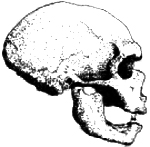Middle Stone Age Research for Undergraduates in Ethiopia
The study of modern human origins and evolution is a multidisciplinary endeavor that closely integrates data from the fields of archaeology, biological anthropology, geochemistry, geochronology, geology, and paleontology. In order for today’s students to become tomorrow’s leading researchers and teachers, they must be trained in the most up-to-date field and laboratory techniques and taught how data drawn from diverse sources are integrated. The Middle Stone Age REU Site in Ethiopia will engage undergraduate students in an investigation of the time period from 40,000 to 90,000 years ago in a region with archaeological sites that preserve the stone tools made and used by these ancient humans, the remains of the animals that they hunted, and a record of past climates. The foraging behaviors practiced by these ancient humans facilitated our species’ migration out of Africa during this time interval.
Students are required to submit an application and will be recruited from a mix of two- and four-year colleges with a general preference for students at the beginning of their college career. They will participate in web-based seminars and conferences that will provide multi-disciplinary training before they begin their field, museum, and laboratory studies. Each student will design a research project, carry out data collection and analysis, and present their results at a national meeting and prepare an article for publication. Students must specify their general areas of research interest as part of the application. However, if during the fall semester training, they are attracted to another research topic, it is possible to switch topics. This project is unique in that it includes:
- Pre-field training in various disciplines and field and lab techniques during the fall semester;
- Approximately one month of field work in Ethiopia starting in late December and concluding in late January;
- One month during the summer of either:
- research with archaeological or fossil materials at the National Museum, Addis Abba, Ethiopia; or
- research in a US laboratory in:
- archaeology (University of Arkansas, Fayetteville, AR; Rutgers University, New Brunswick, NJ);
- geochemistry (Southern Methodist University, Dallas, TX);
- chronology, including: amino acid racemization (INSTAAR, Boulder, CO); cabon-14 dating (Illinois Geological Survey, Champaign, Il); and uranium-series dating (University of Texas at Austin); or
- archaeomagnetism (University of Texas at Austin)
The timetable will cover approximately one calendar year:
- May-June: application due, and selection of students begins
- Fall semester: students participate in weekly web-based seminars
- Late December to late January: students participate in field work in Ethiopia
- Summer: one month of museum work in Ethiopia, or one month of research in a US lab
- Fall: presentation of research results at a national meeting
The project will pay for all expenses* associated with the field work, museum or laboratory research, and travel to and participation in a national meeting. In addition, students will receive a stipend for their month of field work and month of museum or laboratory research. This project is funded by the National Science Foundation.
For an application, please send an email to: MSA_REU@austin.utexas.edu
Associated Files:
